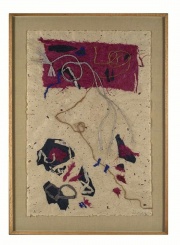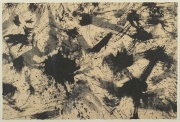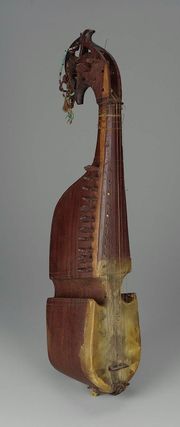Difference between revisions of "Mulberry"
| (10 intermediate revisions by 2 users not shown) | |||
| Line 1: | Line 1: | ||
| − | [[File:1999.706-SC9584.jpg|thumb| | + | [[File:1999.706-SC9584.jpg|thumb|Collage No.164<br>MFA# 1999.706]] |
== Description == | == Description == | ||
| − | Deciduous trees belonging to the mulberry family (Moraceae, genus-''Morus'') are widely found in all temperate climates. These flowering trees produce a milky latex sap and an edible fruit. The white mulberry, ''Morus alba'', is native to Asia and grown in Europe. Its leaves are used as a food supply for silk worms. The roots of the white mulberry and others, such as the Osage Orange mulberry, produce a yellow dye used for coloring prints. The red mulberry, ''Morus rubra'', native to North America, has hard reddish brown wood with an uneven texture and silver graining. It is a rot resistant wood that is used for fence posts, window sills, window frames and shoe lasts. The fruit from the red mulberry has been used for a dark red to purple dye. The colorant is an acid base indicator that turns red in acids and blue in bases. See also [[paper | + | Deciduous trees belonging to the mulberry family (Moraceae, genus-''Morus'') are widely found in all temperate climates. These flowering trees produce a milky latex sap and an edible fruit. The white mulberry, ''Morus alba'', is native to Asia and grown in Europe. Its leaves are used as a food supply for silk worms. The roots of the white mulberry and others, such as the Osage Orange mulberry, produce a yellow dye used for coloring prints. The red mulberry, ''Morus rubra'', native to North America, has hard reddish brown wood with an uneven texture and silver graining. It is a rot resistant wood that is used for fence posts, window sills, window frames and shoe lasts. The fruit from the red mulberry has been used for a dark red to purple dye. The colorant is an acid base indicator that turns red in acids and blue in bases. See also [[mulberry paper]]. |
| − | |||
| − | |||
| + | [[File:2002.145-SC37950.jpg|thumb|Untitled by Mark Tobey<br>MFA# 2002.145]] | ||
| + | * For mulberry fiber identification, see http://cameo.mfa.org/wiki/Category:FRIL:_Red_Mulberry | ||
== Synonyms and Related Terms == | == Synonyms and Related Terms == | ||
white mulberry (''Morus alba''); red mulberry (''Morus rubra''); paper mulberry (''Broussonetia papyrifera''); mûrier (Fr.); gelso (It.); kuwa (Jap.) | white mulberry (''Morus alba''); red mulberry (''Morus rubra''); paper mulberry (''Broussonetia papyrifera''); mûrier (Fr.); gelso (It.); kuwa (Jap.) | ||
| + | [[File:1981.773-SC24706.jpg|thumb|Lute (rabab)<br>MFA# 1981.773]] | ||
| + | == Physical and Chemical Properties == | ||
| − | == | + | * Small tree growing to 15 m with low branches and spreading crown. |
| + | * Bark=gray with irregular ridges. | ||
| + | * Leaves = oval with serrated edges and irregular lobes (5-9 cm). | ||
| + | * Fruit=edible berry (2-3cm long, similar to blackberries) ripening in late summer. | ||
| + | * Density = 35-45 ppcf | ||
| − | + | == Resources and Citations == | |
| − | |||
| − | |||
| − | |||
| − | |||
| − | |||
| − | |||
| − | |||
| − | |||
| − | |||
| − | |||
| − | |||
| − | |||
| − | |||
| − | |||
| − | |||
* R. J. Gettens, G.L. Stout, ''Painting Materials, A Short Encyclopaedia'', Dover Publications, New York, 1966 | * R. J. Gettens, G.L. Stout, ''Painting Materials, A Short Encyclopaedia'', Dover Publications, New York, 1966 | ||
| − | |||
* R.J. Adrosko, ''Natural Dyes in the United States'', Smithsonian Institution Press, Washington, DC, 1968 | * R.J. Adrosko, ''Natural Dyes in the United States'', Smithsonian Institution Press, Washington, DC, 1968 | ||
| − | |||
* F. H. Titmuss, ''Commercial Timbers of the World'', The Technical Press Ltd., London, 1965 | * F. H. Titmuss, ''Commercial Timbers of the World'', The Technical Press Ltd., London, 1965 | ||
| − | |||
* R.D. Harley, ''Artists' Pigments c. 1600-1835'', Butterworth Scientific, London, 1982 | * R.D. Harley, ''Artists' Pigments c. 1600-1835'', Butterworth Scientific, London, 1982 | ||
| − | |||
* ''Dictionary of Building Preservation'', Ward Bucher, ed., John Wiley & Sons, Inc., New York City, 1996 | * ''Dictionary of Building Preservation'', Ward Bucher, ed., John Wiley & Sons, Inc., New York City, 1996 | ||
| − | + | * ''Encyclopedia Britannica'', http://www.britannica.com Comment: "mulberry" [Accessed October 24, 2001]. | |
| − | * ''Encyclopedia Britannica'', http://www.britannica.com Comment: "mulberry" | + | * Virginia Tech Dendrology website at www.fw.vt.edu/dendro/dendrology/main.htm (accessed Oct. 8, 2005) |
| − | + | * Wikipedia: [https://en.wikipedia.org/wiki/Morus_(plant) Mulberry] (Accessed Oct. 8, 2005 and October 2024) | |
| − | * | ||
| − | |||
| − | * Wikipedia | ||
| − | |||
* ''Van Nostrand's Scientific Encyclopedia'', Douglas M. Considine (ed.), Van Nostrand Reinhold, New York, 1976 | * ''Van Nostrand's Scientific Encyclopedia'', Douglas M. Considine (ed.), Van Nostrand Reinhold, New York, 1976 | ||
| − | |||
* Random House, ''Webster's Encyclopedic Unabridged Dictionary of the English Language'', Grammercy Book, New York, 1997 | * Random House, ''Webster's Encyclopedic Unabridged Dictionary of the English Language'', Grammercy Book, New York, 1997 | ||
| − | |||
* ''The American Heritage Dictionary'' or ''Encarta'', via Microsoft Bookshelf 98, Microsoft Corp., 1998 | * ''The American Heritage Dictionary'' or ''Encarta'', via Microsoft Bookshelf 98, Microsoft Corp., 1998 | ||
| − | + | * Museum of Japanese Traditional Art Crafts at http://www.nihon-kogeikai.com/ (Jap. term) | |
| − | * | ||
[[Category:Materials database]] | [[Category:Materials database]] | ||
Latest revision as of 11:56, 18 November 2024
Description
Deciduous trees belonging to the mulberry family (Moraceae, genus-Morus) are widely found in all temperate climates. These flowering trees produce a milky latex sap and an edible fruit. The white mulberry, Morus alba, is native to Asia and grown in Europe. Its leaves are used as a food supply for silk worms. The roots of the white mulberry and others, such as the Osage Orange mulberry, produce a yellow dye used for coloring prints. The red mulberry, Morus rubra, native to North America, has hard reddish brown wood with an uneven texture and silver graining. It is a rot resistant wood that is used for fence posts, window sills, window frames and shoe lasts. The fruit from the red mulberry has been used for a dark red to purple dye. The colorant is an acid base indicator that turns red in acids and blue in bases. See also Mulberry paper.
- For mulberry fiber identification, see http://cameo.mfa.org/wiki/Category:FRIL:_Red_Mulberry
Synonyms and Related Terms
white mulberry (Morus alba); red mulberry (Morus rubra); paper mulberry (Broussonetia papyrifera); mûrier (Fr.); gelso (It.); kuwa (Jap.)
Physical and Chemical Properties
- Small tree growing to 15 m with low branches and spreading crown.
- Bark=gray with irregular ridges.
- Leaves = oval with serrated edges and irregular lobes (5-9 cm).
- Fruit=edible berry (2-3cm long, similar to blackberries) ripening in late summer.
- Density = 35-45 ppcf
Resources and Citations
- R. J. Gettens, G.L. Stout, Painting Materials, A Short Encyclopaedia, Dover Publications, New York, 1966
- R.J. Adrosko, Natural Dyes in the United States, Smithsonian Institution Press, Washington, DC, 1968
- F. H. Titmuss, Commercial Timbers of the World, The Technical Press Ltd., London, 1965
- R.D. Harley, Artists' Pigments c. 1600-1835, Butterworth Scientific, London, 1982
- Dictionary of Building Preservation, Ward Bucher, ed., John Wiley & Sons, Inc., New York City, 1996
- Encyclopedia Britannica, http://www.britannica.com Comment: "mulberry" [Accessed October 24, 2001].
- Virginia Tech Dendrology website at www.fw.vt.edu/dendro/dendrology/main.htm (accessed Oct. 8, 2005)
- Wikipedia: Mulberry (Accessed Oct. 8, 2005 and October 2024)
- Van Nostrand's Scientific Encyclopedia, Douglas M. Considine (ed.), Van Nostrand Reinhold, New York, 1976
- Random House, Webster's Encyclopedic Unabridged Dictionary of the English Language, Grammercy Book, New York, 1997
- The American Heritage Dictionary or Encarta, via Microsoft Bookshelf 98, Microsoft Corp., 1998
- Museum of Japanese Traditional Art Crafts at http://www.nihon-kogeikai.com/ (Jap. term)


